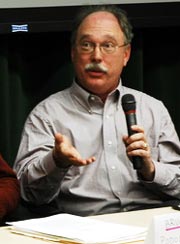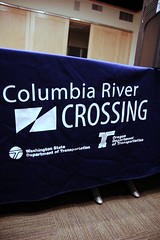UPDATE, 3/3: The Columbia River Crossing project staff have issued a memo refuting Cortright’s claims. Download that memo here (300 KB, PDF).

(BikePortland file photo)
Economist Joe Cortright, who reported last June that Portland’s “green policies” add $2.6 billion into the local economy, has once again set his sights on debunking the Columbia River Crossing (CRC) project.
Cortright’s five-page analysis (download PDF below) raises red flags around several “key issues” surrounding the effort to build a new I-5 bridge over the Columbia River between Portland and Vancouver.
Cortright believes that a new bridge will “induce” more traffic, that it won’t reduce congestion, and that tolling the existing span could cut trips “by as much as half”. He also questions the financing of the project saying that, “$4 billion is a lot of money we don’t have” and that the huge expense will mean the region’s other transportation needs will go unmet “for a decade or more”.
“The big bridge will make traffic worse, not better, by overwhelming capacity in
other parts of the I-5 system.”
–Joe Cortright
Cortright also questions the CRC’s financing plan, calling it “shaky and speculative” and reliant on tax increases that haven’t yet been approved.
Writing about the concept known as induced demand, Cortright says a new bridge will encourage more trips and lead to sprawl:
“The presence of larger transportation facilities encourages people to take trips they would otherwise avoid, or re-route. Over time, transportation facilities lead to more dispersed commuting and business and housing locations – sprawl – and produce more and longer trips. The 20,000 additional trips is a minimal estimate because it does not take account of induced land use changes (and settlement patterns) that will develop over time if capacity is expanded.”
In addition, Cortright contends that, “The big bridge won’t reduce congestion.” Instead, he says, it will make traffic worse by “overwhelming capacity in other parts of the I-5 system”.
From his analysis:
“…How do I-5 and North Portland road networks handle the additional 13,900 peak hour trips that will be generated by the new bridge? Why does a 10% increase in the peak cause catastrophe on the bridge [according to CRC’s own analysis], but a 40% increase on the rest of the system create no problems at all? This is not explained in their analysis.
So, in sum, the CRC position is:
Going from 35,800 to 39,400 on the I-5 Bridge brings the system to a grinding halt; But Going from 35,800 to 53,300 can be accommodated with very high speeds with no bottlenecks elsewhere on I-5 or in the Bridge Impact Area.”
Cortright also contends that if consumers had to pay a toll to cross the Columbia, “traffic volumes would fall substantially”. Citing polls that suggest I-5 bridge crossings would fall by as much as half with a toll, he writes, “if resolving congestion is the problem…tolling the existing facility alone could reduce congestion, and probably do so at a far lower cost.”
On the topic of finances to pay for the project, Cortright says we simply don’t have the money. He points out that the $4 billion cost of the bridge (which would make it the largest public works project in the region’s history) is equivalent to 80 OHSU Aerial Trams and that the it works out to nearly $2,000 per capita from all 2 million residents of the region.
More troubling, according to Cortright, is that the project would drain our region’s transportation budgets “for a decade or more.” He writes,
“…according to Metro’s Regional Transportation Plan, the I-5 and I-205 corridors account for less than 10% of the expected growth in daily travel in the region over the next 25 years. If we spend $4 billion here, how will we meet the other 90% of the expected growth?”
Download Cortright’s Economic Analysis of the CRC (80 KB, PDF).
View more of my CRC coverage here.


